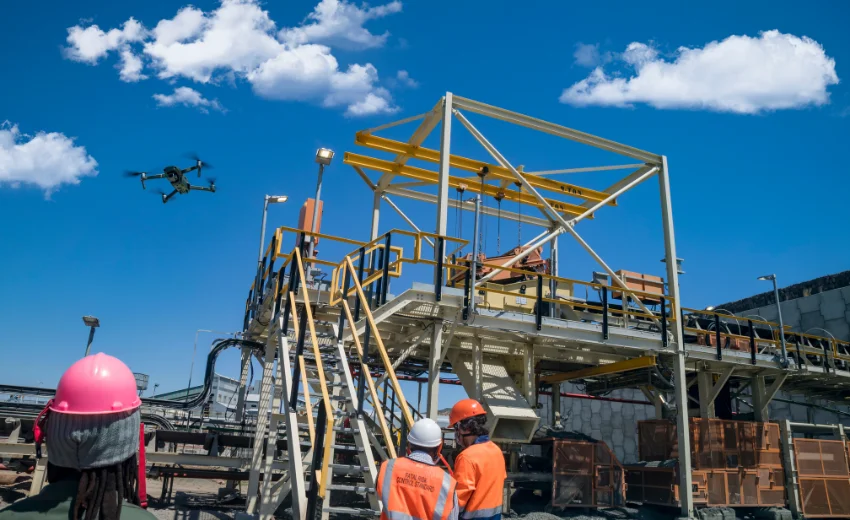The construction industry is undergoing a remarkable transformation with the adoption of cutting-edge technologies, and drones have emerged as a game-changer. Once considered tools for hobbyists or military applications, drones are now integral to modern construction projects. Their ability to gather data, monitor progress, and improve efficiency revolutionizes how construction sites are managed.
This article delves into the various ways drones shape the construction industry, their benefits, and the potential challenges associated with their usage.
- Why Drones Are Vital in Construction
The demand for faster, safer, and more efficient construction processes has never been greater. With rapid urbanization and infrastructure development accelerating, drones offer a unique solution to industry challenges.
Efficiency and Precision
Drones equipped with advanced sensors and cameras can collect data with exceptional accuracy. This eliminates the need for time-consuming manual surveys and ensures precision in planning and execution.
Improved Safety
Construction sites are inherently dangerous, with risks like falls, heavy machinery accidents, and unstable structures. Drones can perform hazardous tasks, such as inspecting hard-to-reach areas, reducing the need for workers to be exposed to potential dangers.
Cost Savings
By streamlining processes like surveying and site monitoring, drones help reduce labor costs and minimize delays. This makes them a cost-effective solution for both small and large-scale projects.
- Applications of Drones in Construction Projects
Drones have found diverse applications in the construction industry, each contributing to enhanced productivity and project management.
Aerial Surveys and Mapping
One of the primary uses of drones in construction is creating detailed maps and surveys. Using photogrammetry and LiDAR (Light Detection and Ranging) technology, drones can generate 3D models of construction sites. These models are invaluable for planning, site analysis, and ensuring projects remain on track.
Site Monitoring and Progress Tracking
Drones can provide real-time aerial views of a construction site, allowing project managers to monitor progress remotely. This is particularly useful for large-scale projects where on-ground visibility is limited.
Key benefits include:
- Identifying bottlenecks or delays in the construction process.
- Ensuring compliance with timelines.
- Communicating progress updates to stakeholders effectively.
Inspection and Maintenance
Drones excel at inspecting challenging or dangerous areas, such as rooftops, scaffolding, or tall structures. They can also check for wear and tear, structural integrity, or construction defects.
For instance, high-definition cameras and drone thermal sensors can identify cracks, leaks, or overheating equipment, enabling proactive maintenance and reducing downtime.
Material and Equipment Delivery
While still nascent, drone-based delivery is gaining traction in construction. Drones can transport small tools, equipment, or materials to workers in hard-to-reach areas, saving time and effort.
Marketing and Documentation
Drones are also proving valuable for marketing purposes. High-resolution aerial footage of construction projects can showcase progress to clients or promote completed projects to prospective buyers.
- Benefits of Using Drones in Construction
The advantages of integrating drones into construction workflows are manifold.
- Enhanced Project Planning
Drones provide comprehensive visual data that aids in better decision-making during the planning phase. With accurate topographic surveys and terrain analysis, projects can be planned more effectively, reducing the likelihood of errors.
- Better Resource Management
Drones offer a bird’ s-eye view of the site, allowing managers to track resources, identify inefficiencies, and optimize the allocation of equipment and manpower.
- Real-Time Updates
The ability to collect and share real-time data ensures that all stakeholders, including contractors, architects, and investors, are on the same page. This transparency fosters collaboration and reduces conflicts.
- Environmental Benefits
Drones help minimize environmental disruption by providing precise data that allows for better land utilization and reduced material waste.
- Challenges and Limitations of Drones in Construction
Despite their numerous advantages, drones are not without challenges. Addressing these issues is crucial for their widespread adoption.
- Regulatory Hurdles
In many regions, the use of drones is subject to strict regulations, including licensing requirements and operational restrictions. Construction firms must navigate these rules to avoid penalties or project delays.
- Technical Limitations
- Battery Life: Drones typically have limited flight times, requiring frequent recharging or battery replacement.
- Payload Capacity: While drones can transport small items, they still need to be able to handle heavy materials or tools.
- Skill Requirements
Operating drones and interpreting the data they collect requires trained professionals. The need for skilled operators can be a barrier for smaller firms.
- Privacy and Security Concerns
Using drones raises questions about data security and privacy, particularly in urban settings. Construction companies must ensure their drone operations comply with privacy laws and safeguard sensitive data.
- The Future of Drones in Construction
As drone technology continues to evolve, its potential applications in construction are set to expand further. Here are some trends to watch for:
- AI-Powered Drones
Integrating artificial intelligence (AI) with drones will enable automated inspections, real-time analysis, and predictive maintenance, further streamlining construction processes.
- Improved Battery Technology
Advancements in battery technology are expected to increase drones’ flight duration, making them more practical for extended operations.
- Integration with BIM (Building Information Modeling)
Combining drone data with BIM systems will provide construction teams with a comprehensive understanding of project dynamics, improving coordination and accuracy.
- Swarm Technology
Using multiple drones, known as swarm technology, could revolutionize large-scale construction projects by enabling faster data collection and resource distribution.
Conclusion: Drones as Catalysts for Innovation
Drones have become indispensable tools in modern construction projects, offering unparalleled efficiency, precision, and safety. From aerial surveys to real-time progress tracking, their applications are transforming the industry. While challenges like regulatory compliance and technical limitations persist, the benefits outweigh the drawbacks.
As technology advances, drones will play an even more significant role in shaping the construction landscape, driving innovation, and ensuring sustainability. For construction firms, embracing drone technology is not just an option—it’s necessary to remain competitive and deliver exceptional results.
By understanding and leveraging drones’ potential, the construction industry can build smarter, safer, and more efficient projects in the future.

